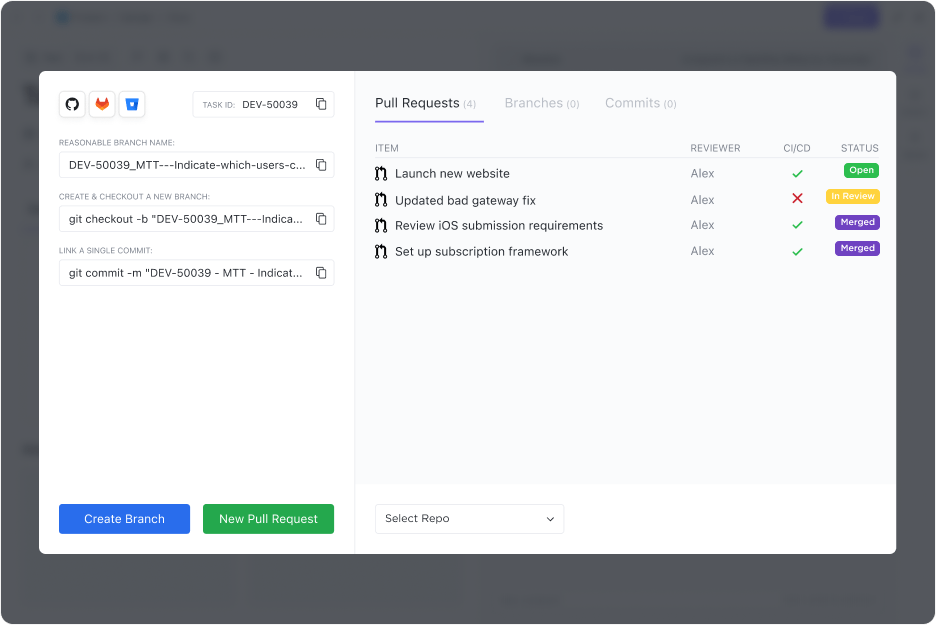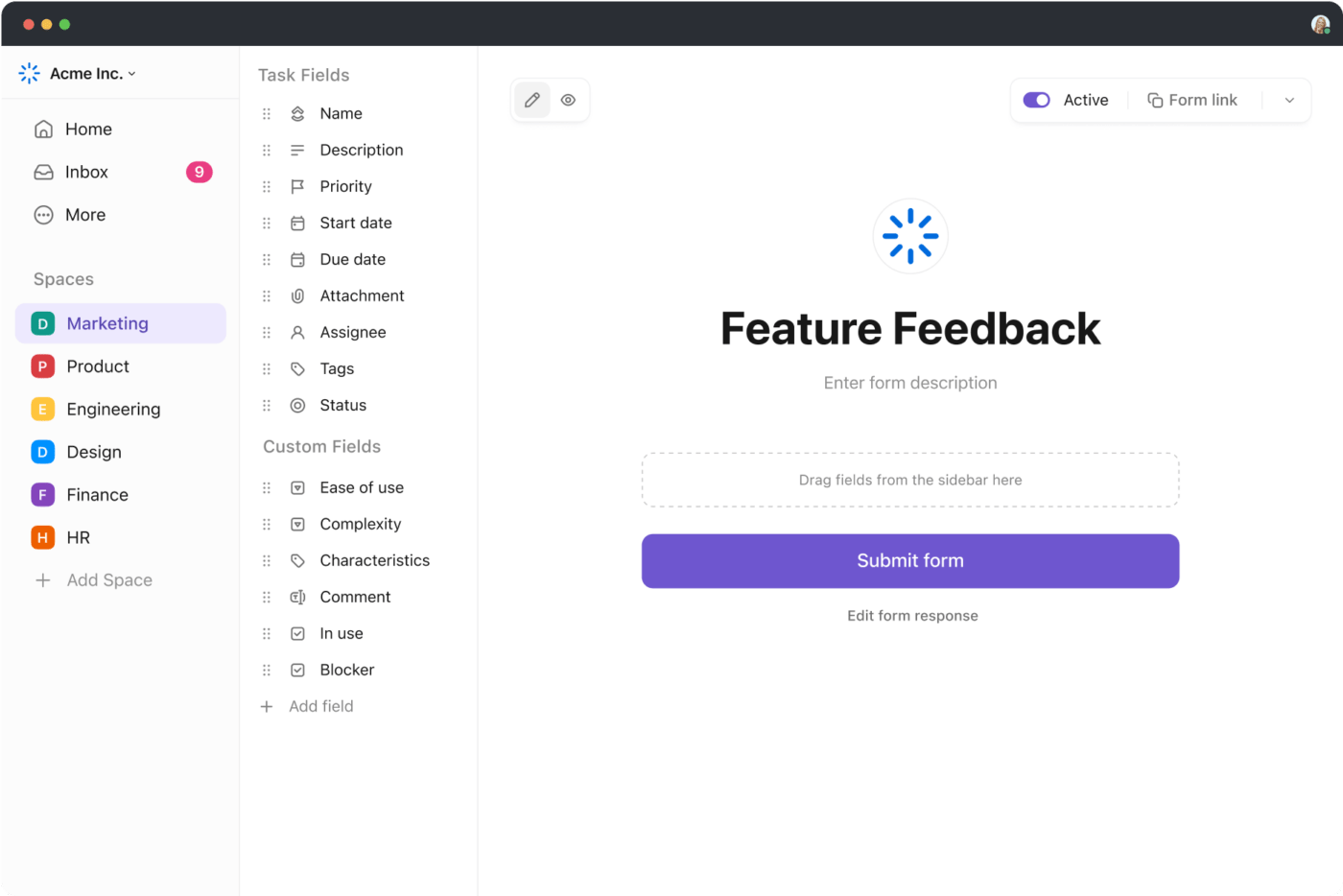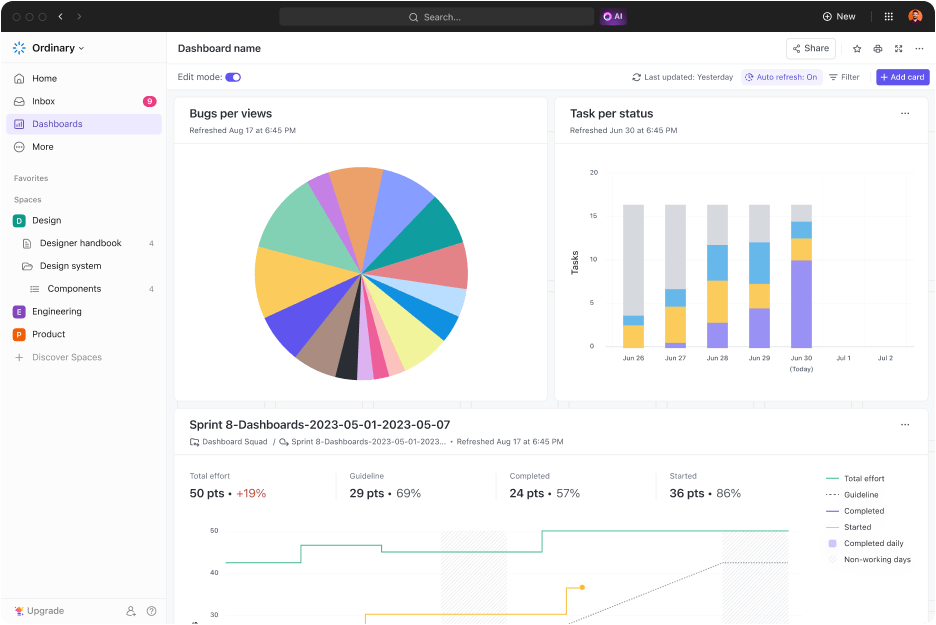

Picture yourself as a top chef who’s worked in fancy restaurants and is famous for creating magic with food. You have the skills and experience to conjure culinary wonders and impress your guests. But here’s the twist—all your Michelin stars are worthless without a good oven, pans, pots, knives, and all the other tools a chef needs to create tasty food. 🧑🍳
The same goes for DevOps teams. They need clearly defined tools, processes, and practices to showcase their skills and deliver value, and that’s precisely what a DevOps pipeline sets them up with.
In this guide, we’re taking a peek into a typical DevOps pipeline and unpacking its key stages and components to help you cook one for your DevOps team. We’ll also introduce a fantastic software development project management platform to help you manage your DevOps processes.
What Is a DevOps Pipeline?
A DevOps pipeline is a collection of automated processes and automation tools that facilitate continuous integration, continuous testing, and reliable deployment of software products.
The main goal of a DevOps pipeline is to help development and operations teams streamline and automate the software development lifecycle. By doing so, a DevOps pipeline ensures efficient software delivery without jeopardizing quality while promoting collaboration and consistency.
Just like every company and software product is unique, so is its DevOps pipeline—you tailor it based on your team’s dynamics, requirements, and budget. Yet, every DevOps pipeline has the same objective—automating processes to minimize mistakes and deliver value faster. So, it’s no surprise that most pipelines have similar components and stages.
5 DevOps Pipeline Components
Let’s review the components you should rely on when building a DevOps pipeline:
1. Continuous integration and continuous delivery
These two components typically go hand-in-hand; you’ll often see them referred to as CI/CD or CI/CD pipeline.
Continuous integration refers to the process of making constant code commits (code integrations) to the central repository. Simply put, it encourages adding small chunks of code into the shared base, preferably a few times a day, instead of working on isolated code branches. Continuous integration is your get-out-of-merge-hell card. It allows:
- Easy merging of code changes
- Early bug identification—the earlier you catch bugs, the easier you’ll fix them
Closely related and dependent on continuous integration, continuous delivery automates various processes necessary for delivering software to production or a staging production environment. It involves automated, continuous testing that ensures new code changes don’t impact the existing functionality. Thanks to continuous delivery, you’re always on standby when it comes to product release—all it takes to deploy your product is a click of a button.
As you’re in charge of your DevOps pipeline, you can choose whether to release daily, weekly, or monthly. But, if you want to maximize the benefits of continuous delivery, deploy as soon as possible to make troubleshooting easier.
2. Continuous deployment
Continuous deployment is often confused with continuous delivery, so let’s clarify the difference. Deployment automates the entire release cycle and ensures code updates that pass automatic testing reach end users without intervention. Likewise, the release of code updates will be stopped if an issue is detected during the delivery or, more precisely, during testing.
You can think of continuous deployment as an extension of continuous delivery that highlights the importance of delivering features quickly and efficiently.
Continuous deployment requires a stable automated testing process, team coordination, and meticulous planning, but not every company needs it. If you don’t release features daily or hourly, continuous deployment isn’t essential.
3. Continuous feedback
The Achilles heel of the traditional software development model is the lack of timely feedback. It took months and even years to turn an idea into reality, and considering that software development is a dynamic industry, the end results usually didn’t meet expectations.
DevOps methodology recognizes the importance of timely and continuous feedback to ensure the end product ticks all the boxes and has no issues. That’s why DevOps teams focus on incremental releases—taking one step at a time allows for:
- Adjustments on the fly
- Being 100% confident that the product aligns with users’ expectations
Development and operations teams rely on automating feedback to get continuous input and insights, as well as early warnings in case of issues. That way, they can jump to fixing bugs as soon as possible.
4. Continuous monitoring
Continuous monitoring focuses on the security aspect of your project. It checks whether your project meets compliance requirements and pinpoints abnormal activity that could jeopardize stability.
You establish KPIs you want to track, like error rates or latency, and analyze them for bottlenecks. Continuous monitoring also includes log analysis—your system will “tell” you what’s wrong if you know how to listen.
5. Continuous operations
This component revolves around minimizing or eliminating downtime and keeping your operations smooth and consistent. If there is downtime, you should ensure it doesn’t disrupt your users—this means scheduling repairs and maintenance.
There are different continuous operations tactics to choose from. For example, you could have an on-call team that could resolve issues or a team working the night shift. You could also set up backup systems to prevent downtime and keep your operations running smoothly.
How to Create a DevOps Pipeline: 5 Steps
Setting up a functional DevOps pipeline that aligns with your software development needs requires employing a specific set of DevOps tools and custom procedures. Every pipeline is unique, but there are a few universal steps for creating one.
1. Select your CI/CD tool
The first item on your to-do list is choosing a CI/CD tool that will allow you to automate and accelerate development, testing, and deployment, avoid bugs, and streamline workflows.
You’ll find plenty of quality CI/CD tools on the market, including Jenkins, TeamCity, and CircleCI, and each offers a unique feature set. There’s no magic recipe for selecting the best one—consider and prioritize your needs and goals and see which tool measures up.
2. Set up a control environment
Your DevOps team needs a home, i.e., a version control system to share and store different code, app, and software versions, collaborate, and minimize the risk of merge conflicts.
Again, which tool you’ll choose depends on your requirements and priorities, so explore a platform’s features in-depth before deciding.
3. Establish a build server
Also known as a continuous integration server, a build server acts as an integration point where your developers can check whether specific code works before deploying it to the production phase.
4. Configure testing tools
Once your code is up on the build server, you move on to the testing phase to check if it’s error-free and move it down the line. Of course, your team doesn’t go line by line to check the code—they use different types of automated tests that examine its functionality and stability. Only squeaky-clean code can be moved to the deployment stage.
5. Deploy to production
In the final step, you push your code to production, and you can do this manually or automatically. The latter sounds like a better, more time-efficient option. But remember that with automatic deployment, it’s easier for issues to fly under the radar. That’s why many organizations prefer manual deployment to have more control over the process.
How Can ClickUp Help You Streamline Your DevOps Pipeline?
ClickUp isn’t a tool for writing, testing, or deploying code. It’s also not a platform for monitoring server performance or managing IT infrastructures. Hmmmmm—why on Earth would you need it for your DevOps pipeline?
Well, ClickUp can be the backbone of your DevOps pipeline and serve as a mission control center from which you can manage every DevOps process and workflow. This task and project management platform for software teams packs options that encourage collaboration, communication, and effortless task assignment and organization. At any time, ClickUp can provide vital info on the health of your DevOps pipeline and ensure your software delivery is going as planned.
Let’s see what makes ClickUp an excellent addition to your DevOps pipeline. 👇
ClickUp integrations
One of the reasons why ClickUp fits so neatly into your workflows is its ability to integrate with 1,000+ tools, including calendars, communication and collaboration apps, time-tracking platforms, and human resources and sales software.

You’ll be happy to know that ClickUp can connect to GitHub, a top-notch development platform that gives you complete control over your DevOps pipeline. With this integration, you can link pull requests, commits, and branches to ClickUp tasks and track their progress. On top of that, you can:
- Receive notifications about GitHub activity items
- Manage source code repositories
- Identify and monitor issues without leaving ClickUp 😍

Another similar but no less interesting integration is GitLab. This open-source platform offers fantastic customization options, making issue tracking, code reviewing, and managing pull requests, commits, and branches a breeze.
ClickUp also integrates with Zapier, so you can easily connect it to 6,000+ apps and platforms, including DevOps superstars like Jenkins, Azure DevOps, and BasicOps.
If that’s not enough, you have another option—building custom integrations with ClickUp API.
Whatever you choose, you’ll be able to turn ClickUp into an all-in-one platform that minimizes context switching and ensures transparency and visibility in your DevOps pipeline.
ClickUp Tasks

ClickUp is a task management master, allowing you to plan and organize your work down to the smallest details.
The ClickUp Tasks feature suite allows you to easily create tasks and subtasks and incorporate them into your workflows. Choose from various task types (like Task, Milestone, Feature, or Issue) and ensure seamless navigation and categorization.
When creating tasks, use Custom Fields to provide more details and be confident your team knows what’s expected of them. For example, you can use the Progress Custom Field to automatically track the completion of tasks and subtasks and see how close you are to your goal.

Customizability is at the core of ClickUp, and task management is no exception. You can use custom statuses to personalize your workflows, assign one task to multiple people, set recurring tasks, and create custom tags for categorizing tasks.
Ensuring proper order is never an issue because ClickUp lets you set relationships and dependencies between tasks to connect related work.
ClickUp views

Observing a project from various angles gives you a holistic understanding of your workflows and lets you pinpoint potential issues early on. ClickUp lives by this philosophy and offers 10+ options for viewing your work, your way.
If you’re looking for a classic, use the ClickUp List view. It comes by default in all Lists, Folders, and Spaces and is ideal for organizing and grouping tasks according to various criteria.
Keep a close eye on the statuses of your tasks with the ClickUp Board view. This Kanban board-like view lets you keep your projects moving by dragging and dropping tasks into adequate columns. Besides statuses, the ClickUp Board view allows you to arrange and visualize tasks based on priority, assignee, or any other criterion.
As DevOps teams can’t thrive without collaboration and communication, you’ll love the ClickUp Chat view. With it, you can:
- Assign work
- Exchange real-time messages with your team
- Use comments and mentions to turn their attention to something specific
The ClickUp Chat view can be the perfect replacement for popular team communication tools and can reduce context switching. Instead of jumping between apps, you can get everything done in ClickUp. That way, you maintain focus and improve productivity. 💪

Another view you should look into is ClickUp Forms. It’s an excellent tool for ensuring continuous feedback from your team members, stakeholders, and end users. Open the view and use the task fields on the left side of the screen to customize your form, ask the right questions, and collect relevant info. ClickUp analyzes the information and turns it into actionable tasks to keep your team going in the right direction.
ClickUp Whiteboards

DevOps team members rely on each other—everyone’s responsible for the product throughout all DevOps pipeline stages, from planning to deployment and monitoring. This makes efficient collaboration and communication your number one priority, and there’s no better tool for that than ClickUp Whiteboards.
Whiteboards are digital canvases ideal for brainstorming, strategizing, and creating a bulletproof game plan for delivering value. On this canvas, your team can write, draw, add shapes, attach files and links, post sticky notes, and work together in real time to turn ideas into reality. 🎨
Create tasks right within Whiteboards or link to tasks, Docs, or files to add more context.
ClickUp templates
With a library of over 1,000 ready-made templates, ClickUp has every trick in the book to support you toward achieving your goals and save time in the process. ⌚
For example, you can use the ClickUp Roadmap Template DevOps Teams to define strategic goals, timelines, and milestones and drive continuous improvement. The template enhances your team’s agility and helps you determine priorities and adjust to changing circumstances.

Another DevOps-friendly template is the ClickUp DevOps Work Breakdown Structure Template. With it, you can divide projects into tasks, assign duties, monitor progress, and seamlessly adjust whenever necessary.
Thanks to its comprehensiveness, the template helps you spot and address bottlenecks before they cause trouble. 🔨

ClickUp Dashboards
Is your DevOps pipeline functional as it is or needs improvements? What is your team’s deployment frequency, change failure rate, lead time, or mean time to recovery? Find out answers to these questions and many more with ClickUp Dashboards!

Dashboards in ClickUp are fully customizable—choose from 50+ cards to personalize your dashboards and get insight into the metrics you’re currently interested in. Ensure proper resource allocation, get a bird’s eye view of the entire project, and track time to keep your team going in the right direction.
ClickUp Brain

Juggling projects and teams is no easy feat, and if you need a helping hand, use ClickUp Brain. 🧠
This revolutionary feature is the world’s first neural network. It harnesses AI to connect ClickUp Docs, teams, tasks, and your company’s entire know-how to help you save time and easily manage work.
Essentially, ClickUp Brain learns everything about your company and is able to provide answers to all kinds of questions, from What are the most urgent tasks? to What’s the company’s PTO policy?
With instant, accurate results, ClickUp Brains becomes the brain behind your operation, centralizing information and promoting productivity across the board.
Build and Maintain a Steady DevOps Pipeline with ClickUp
DevOps teams can’t excel at their work without proper support in terms of task and project management and an efficient tool for collaboration, communication, tracking progress, and collecting feedback.
ClickUp covers all these aspects and helps you streamline workflows, pinpoint inefficiencies, and offer maximum support to your DevOps pipeline.
Sign up for ClickUp today and give a boost to your DevOps process!



